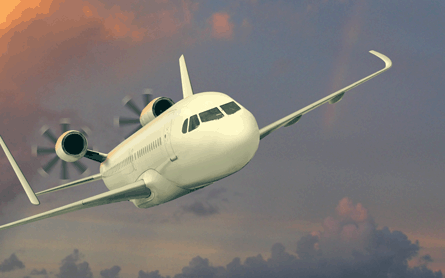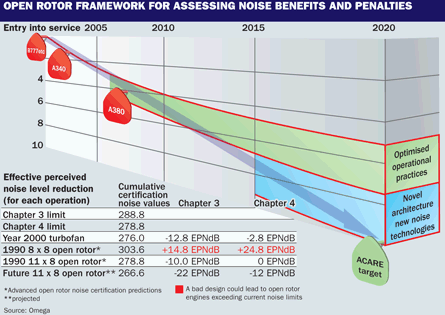Heralded as one of the most promising routes to a more sustainable future for the aircraft industry, advanced open rotor engines could hold the key to achieving a dramatic improvement in the fuel efficiency of the next generation of aircraft.
But only if the engines overcome one of the principal showstoppers: noise.
On paper, open rotor powerplants can at least reduce carbon emissions by up to 30% compared with turbofan engines on short and medium-haul aircraft, hence their attraction.
If what we know about turboprop technology is anything to go by, they are liable also to create something of a racket, a design attribute that does not figure high on any regulator's wishlist.
 |
|---|
© Flight International/Tim Bicheno-Brown |
Contra-rotating propellers generate higher level of noise than their single rotation equivalents. Noise is mainly generated when the wake from the front rotor disc passes through the rear rotor disc. That interaction between the blades in the rear row and turbulent flow present in the wake, and especially with tip vortices shed from the front rotor, create yields in pressure fluctuations that manifest themselves as noise.
Manufacturers, policy-makers and airports need therefore to be able to predict well in advance the trade-offs between noise performance and carbon emissions of any future engine design.
Considerable time and money is already being spent by the industry. General Electric is teaming with NASA to revive studies of its long-abandoned GE36 unducted fan and has dusted off the original test rigs used during the $1.2 billion programme almost two decades ago. Rolls-Royce too is reviving its early foray into open rotor technologies.
Noise is frequently cited as one of the principal stumbling blocks that thwarted the original propfan projects that foundered when high 1980s oil prices returned to more comfortable levels.
In an effort to develop an independent perspective, Omega, the UK aviation research initiative sponsored an academic study to investigate the likely noise impact of several generic designs of large open rotor-powered aircraft during an entire flight operation from take-off to landing
Essentially, this tool attempts to demonstrate what likelihood there is of engine makers meeting ever-increasing noise restrictions by developing an independent trade-off tool for balancing noise costs against emissions benefits.
Speaking at the Omega dissemination conference earlier this month, Dr Rod Self of the Fluid Dynamics and Acoustics Group of the Institute of Sound and Vibration Research (ISVR) at the University of Southampton told delegates: "On the one hand it's very much a scientific problem and on the other it's a problem about how people react to noise. Noise is something tangible, something people can get hold of and it articulates people's concerns about aviation in general."
Designers of aircraft engines therefore have essentially to understand the wider environmental impact of their work, not just the technological consequences and endeavour to optimise both in terms of reducing aviation's impact on climate change.
In terms of industrial strategy, any hardware that can significantly enhance climate change mitigation efforts represents a potential gamechanger. Low-cost carriers such as EasyJet have long made their opinion clear on the necessary leap in single-aisle technology they are targeting in the not-too-distant future. Notwithstanding the current global recession, the narrowbody fleet will remain significant.
Self's team at the ISVR set out to gather together as much of the available modern open rotor design philosophies on which to base its calculations as it could. "Industry obviously doesn't like to give information out into the public domain when they have not begun to build their own engines," he notes.
The fruits of this search laid the framework that applied the latest prediction methodologies to produce a unique open rotor noise/aerodynamic prediction tool designed specifically for open rotor aircraft.
Using some 18-year-old NASA public domain advanced open rotor noise prediction code the team was, with the support of Alexios Zachariadis at the University of Cambridge, able to incorporate the effect of propeller incidence on noise radiation as well as lay the first steps for a method to incorporate computational fluid dynamics simulations into "hybrid" noise prediction.
KNOWLEDGE GAPS
All these forecast open rotor effects using the prediction tool methodology will be combined and used to identify and overcome any knowledge gaps in noise modelling, investigate certification compliance and allow designers to compare new aircraft types with conventional turbofans. The potential impact they may make will be highlighted, as will likely public acceptance.
It was the team's work on two alternative tip vortex interaction noise models that gave the first fascinating clues as to what the public might expect to hear if the future of aviation is indeed propeller-shaped.
Dr Michael Kingan, discussing the ISVR's work on developing the prediction tool, explained that the open rotor aircraft noise spectrum - or sound texture - is dominated by tones with only a contribution of broadband noise - which typifies modern turbofans and which is arguably easier on the human ear.
Working alongside the noise prediction effort, the ISVR also developed a working framework to assess noise benefits and penalties of fundamental changes to aircraft and engine design in additional to optimised operational practices.
 |
|---|
As the ISVR's Jack Lawrence explains, one cannot simply compare a turbofan aircraft with an open rotor aircraft without detailed design and operational data.
So a set of 150-seater turbofan parameters from around the year 2000 were compared with an open rotor aircraft of a 1990 design vintage that used two open rotors - a suboptimal 8 x 8 bladed design and a better design in an 11 x 8 bladed configuration. Both produced the same amount of thrust as the twin-turbofan aircraft, even though an actual open rotor aircraft would require less thrust because of its reduced fuel-weight fraction.
The auralisation case studies produced demonstrated synthetically what an 8 x 8 bladed and an 11 x 8 bladed engine would sound like if a member of the public was, for example, standing in line with the flyover path of an open rotor aircraft flying at 1,000ft (300m), with its engine at cutback and at 3° of attack, with high-lift devices deployed and landing gear up.
Because open rotor aircraft produce a significant number of tones, they must be added together to produce the auralisation, which also calculates the sound pressure produced by each of these tones at the observer position as a function of time. The method also accounts for a variety of source (strength, directivity and frequency) and propagation effects (atmospheric absorption, Doppler shift and observer distance), with the sound produced by the individual tones summed together assuming random phasing.
SECOND IMPRESSIONS
ISVR's Dr Ian Flindell provides a note of caution. "When comparing the two auralisation examples, you'll often remember the second as you heard it the most recently. For once, it's a case of first impressions not counting.
"You also have to remember that what we have here is very much an estimated prediction, with the volume not calibrated for ambient conditions. I can't stress the caveats importantly enough as while the sound may be accurate, the perception of that noise may be way off."
Although the effect of refraction due to temperature/wind gradient was not taken into account, the playbacks were impressive and could hold significant potential for a more precise assessment of human perception of open rotor noise. In fact, an auralisation programme is now actively being developed that allows auditory simulations of aircraft noise to be used in listening tests.
While the early auralisation attempts give no more than a rough indication of open rotor noise, the team reports that the consensus view is that the most advanced open rotor technology would meet Chapter 4 requirements "comfortably" when compared with a conventional turbofan in terms of certification at a conceptual design level.
"While open rotor aircraft will be quieter than the aircraft they replace, their noise benefits will however be less than for a future advanced turbofan, so immediately a trade-off becomes apparent," says Self. He adds that studies such as these are essential in giving the industry confidence in future technology strategy.
The research by Lawrence further demonstrates that, with changes to the aircraft's operation compared with an equivalent 150-seater single-aisle turbofan-powered aircraft, a cumulative certification reduction of at least 12 EPNdB may be achieved with future open rotor engine designs.
Open rotor noise is highly tonal and different in character from conventional turbofans and the potential community acceptance of this "different" sound needs further research. "Open rotor aircraft may be Chapter 4-compliant, but perhaps we will need a new regulatory framework to take into account this distinctive multi-frequency highly tonal character," says the ISVR's Ieish Gamah, who has studied these aspects in depth.
WHAT NEXT?
As GE and R-R could end up running their open rotor efforts alongside the more conventional advanced turbofan demonstrators before the end of 2020 - no doubt throwing down the gauntlet to Pratt & Whitney's geared turbofan ambitions - Omega's industry stakeholders have unsurprisingly expressed the need to extend the ISVR model to encompass differing design scenarios such as turboprops and geared turbofans.
As Flindell points out: "We just can't make judgements on a like-for-like comparison basis when talking about very different beasts."
To give that level of detail on a comparative aircraft design and performance analysis basis, the ISVR team need access to powerplant geometry and location information, not to mention specific aerodynamic data.
There has also been considerable discussion about developing a model capable of accurate predicting cabin noise in aircraft powered by open rotors - perception on board this time as well as likely en-route noise back on terra firma.
While noise modelling and auralisation techniques need to be finessed, there is broad stakeholder consensus that for open rotor aircraft to stand a chance of rolling off the production lines, a user-friendly, front-end tool needs to be developed so any new aircraft engine and airframe design can be assessed.
But why bother if advanced turbofan architecture is likely to outshine the best-ever performance that an open rotor aircraft design department can deliver? Self counters that there is everything to play for. "The flight demonstrators in the 1980s were not designed or built terribly well. We think we could probably do better this time around."
Source: Flight International























